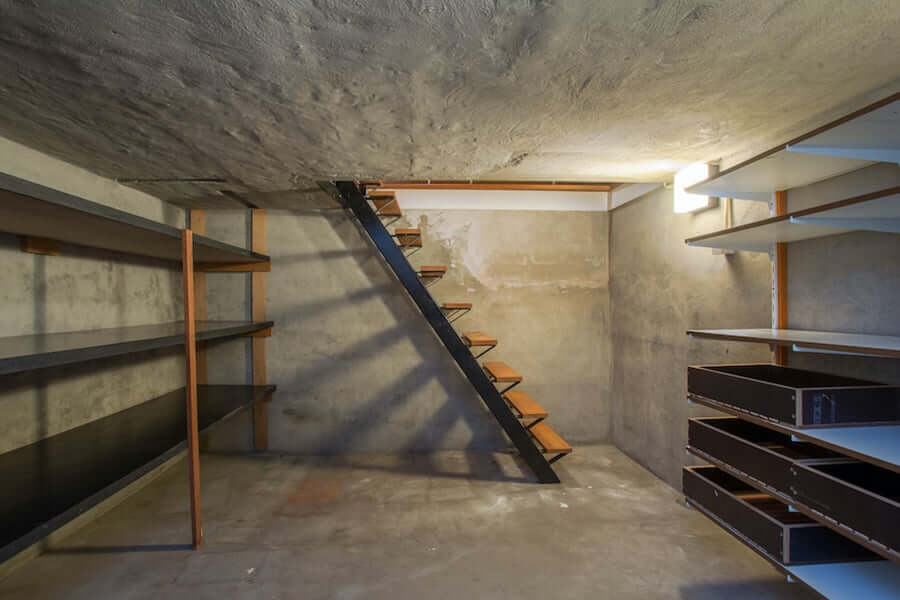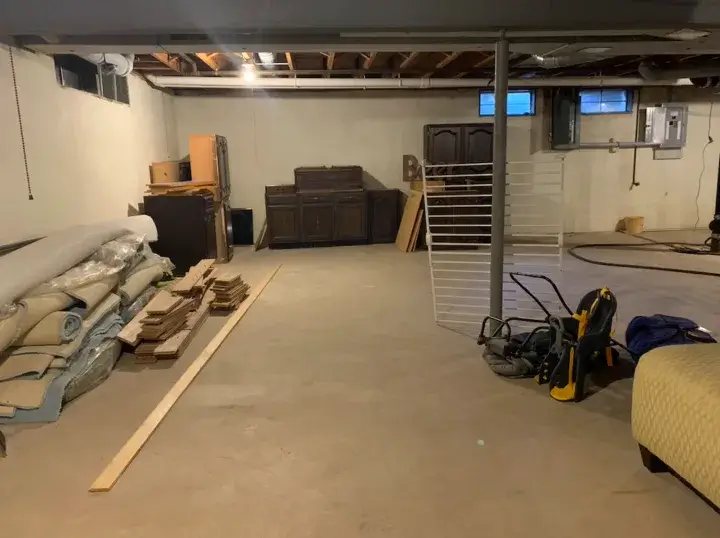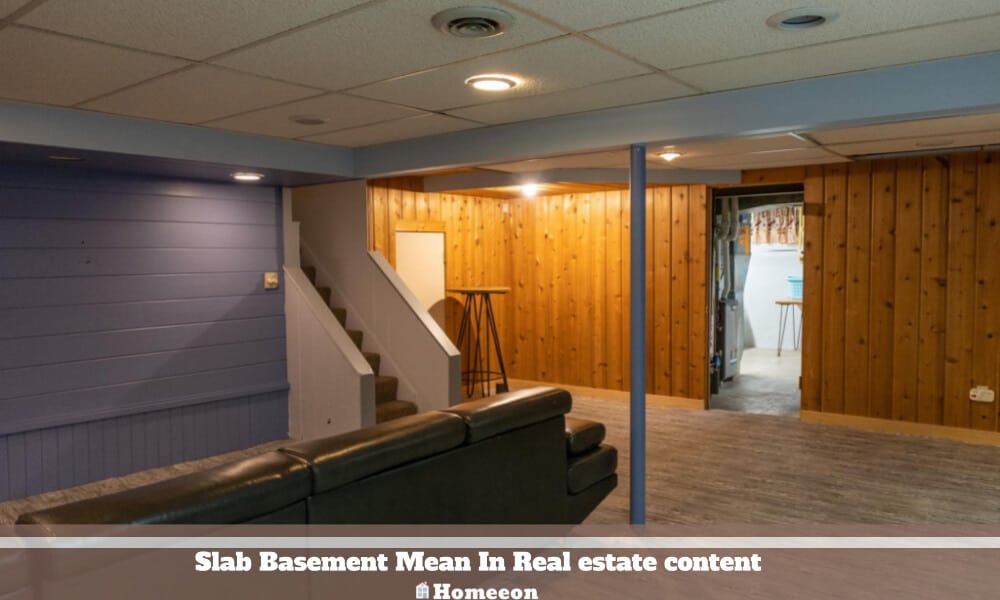Last Updated on August 1, 2023 By Emma W. Thomas
In real estate, a slab basement refers to a type of foundation where the house is built directly on a concrete slab at ground level, without any crawl space or basement area beneath. It offers a sturdy and cost-effective option for home construction.
Understanding ‘Slab Basement’ in the Real Estate World
When navigating through the labyrinth of real estate terminologies, one might often come across “slab basement.” This term, while frequently used, is not always clear to everyone. This article aims to provide an insight into what slab basement means in the real estate context.
- Definition of a Slab Basement: A slab basement, otherwise referred to as a concrete slab foundation, refers to a type of basement built directly on soil with a thin layer of concrete, usually about four inches thick. This kind of basement lacks the traditional crawl spaces or basement areas beneath the primary level of the house.
- Construction Process: Construction of a slab basement is quite straightforward and efficient. Once the site is leveled and the outside footings installed, a layer of gravel is laid. Concrete is then poured directly onto this gravel layer and reinforced with steel. This creates a concrete slab on which the house sits.
- Cost Effectiveness: Since slab basements require less material and labor, they are usually cheaper to construct compared to other types of basements. They eliminate the need for a large excavation, thus reducing the overall construction cost.
| Type of Basement | Approximate Cost |
|---|---|
| Slab Basement | $4-7 per square foot |
| Crawl Space | $7-14 per square foot |
| Full Basement | $10-35 per square foot |
- Energy Efficiency: With no space underneath for air to move, a slab basement can improve the thermal efficiency of a home, reducing heating and cooling costs. Heat is not easily lost to the ground, making it a sustainable home option during winter months.
- Limitations and Concerns: There are limitations to slab basements. A slab basement can face significant issues if the ground upon which it is poured is not appropriately prepared. Uneven terrain may lead to cracks in the slab over time. Moreover, accessibility to utilities such as plumbing and electrical systems is limited as they are often embedded in the concrete slab.
- Ideal Locations for Slab Basements: The slab basement is commonly found in warmer climates where the ground doesn’t freeze and causes potential damage to the foundation. These basements are more prone to damage in areas prone to earthquakes or soil shifts.
What Are The Advantages Of Slab Basements?

Slab basements have both advantages and disadvantages when compared to others. Some of the benefits include:
Budget-Friendly
Slab basements are a low-cost option for most people, especially when building a house on a budget. You will require fewer materials and complete the process much faster as compared to other options. It will enable you to save on labor costs since the process will take a shorter period.
It Is A Simple Option.
If you are building your home from scratch, a slab basement is the simplest option. This type of basement takes a little time to prepare and dry as compared to others. It is also faster and easier for the constructors to complete.
Minimized Risk Of Damage From Leaking Gases And Flooding
Slab foundations reduce the risk of injury from leaking gases or flooding. The concrete protects you from gases like radon from a crawlspace or basement into the house.
Protection From Pests
A concrete slab protects your home from pests such as termites and other similar insects. It does not leave any open spaces below the house that could provide access to supports or wooden joists that the insect could chew.
Fewer Steps
Unlike homes that have crawlspaces or basements, slab homes are built near the ground. Doing this reduces the number of steps that are needed to enter the house. Easy access is beneficial, especially for people who are physically challenged.
What Are The Disadvantages Of Slab Basements?
While a concrete slab has its advantages, there are also some disadvantages associated with this basement that include;
Pests Can Enter Through The Walls
Pests such as termites cannot access your home from beneath it. But, they can come in through the walls because the house is close to the ground. This problem is prevalent if the wall sits on the floor and it is wooden.
The Need To Insulate Ductwork
Ductwork for air conditioning and heating runs through the ground-floor ceiling. For this reason, there is a need for heavy insulation for the retention of appropriate temperature.
Slab Cracks
One of the significant disadvantages of slab basements is cracking. If the concrete cracks, it will significantly compromise your house’s structural integrity, which will become expensive and difficult to repair. Slab cracking can be as a result of frozen ground, soil displacement, tree roots, and earthquakes.
Installation Of Cooling And Heating Units
With a slab basement, you may have to install a furnace and air-conditioning units on the ground floor. Doing this means taking up space that could be used for other purposes.
Is the Slab Basement Bad?
A slab basement, just like a crawlspace foundation, has its advantages and disadvantages. One of the benefits of concrete slabs is building on grade over soil that is not disturbed. When this is done, and the conditions allow, there will be less excavation, fewer labor requirements, and minimized forming costs.
When it comes to pests and termite prevention, a concrete slab is a preferable option. These microorganisms cannot gain access from under the house, and they are kept at bay. The slab basement also minimizes energy bills since it helps to insulate your home. In case of a leaking shower pan or toilet, the concrete slab will not rot.
A home built on a slab is generally close to the ground and requires only a few steps to enter or exit, making it advantageous to people with disabilities. It is more beneficial to those in wheelchairs.
However, a slab basement minimizes access to ventilation, heating, or air-conditioning systems. The ductwork is also installed underneath the floors of the home or on a crawlspace. It is also expensive to repair any utilities in the slab. For example, fixing an electrical or plumbing system requires you to remove the entire concrete.
If your slab has poor building or finishing techniques, it can result in uneven spots and floors. Moisture and water may also rise through any cracks in the concrete resulting in damage to the floors and finishes. A concrete slab may also be termed as a cheaper option by some individuals, lowering the home’s resale value.
Which Is Better, A Slab Or Crawlspace Foundation?
Whether a crawlspace or slab foundation is better depends on several factors such as climatic conditions, costs, height, and installation. For example;
Crawlspace foundation is suitable in areas prone to earthquakes since the earth’s shifting can permanently damage a slab foundation. This foundation is also ideal for red clay since these soils have no stability required to support a cement slab. A crawlspace will work well in sloppy areas where footers can be constructed to level the home’s flooring.
Crawlspace foundations are also recommended for flood-prone areas as well as dry conditions as moisture accumulates there. It is unlikely for a home with a raised crawlspace to flood.
A concrete slab, on the other hand, is suitable for a wet but not flood-prone condition. In these areas, moisture is likely to build up within a crawlspace. A vapor barrier that lies underneath the slab prevents the growth of mold in the home.
Comparisons Between Crawlspace And Slab Foundations
| Slab Basement | Crawlspace Foundation |
| A concrete slab is built closer to the ground, and this requires fewer steps, making it ideal for people with mobility issues. | Height ranges from 16-inches to 4-feet. There’s a need for entrance ramps for ease of mobility. |
| Costs range between $7,500 and $12,000 for an average-sized home, excluding plumbing and electrical installations. The price depends on home size, the area, and home layout. | Approximate costs range from $10,000 to $25,000. The cost depends on the number of footers required and the number of foundation corners. |
| Depending on the professionalism and quality of materials used in construction, a slab foundation can last about 50-years or more. Durability will also depend on whether there is root intrusion or shifts in the earth underneath the home. | A crawlspace can also last the same number of years as a concrete slab if there is no insect infestation or violent flooding. |
| Integrity is not affected by a leaky pipe or shower pan. However, Repair may be costly since it involves removing and replacing the foundation’s concrete. | Can rot due to leaky pipes or shower pan, and hidden water leaks can lead to extensive repairs. But, repairs are easier and do not involve removing the foundations. |
| Large tree roots can damage it. | Tree roots cannot damage it. |
| A slab prevents access for pests and vermin beneath the house. The earth is pre-treated for pests and termites to avoid problems beforehand. | Separation from the earth below prevents termites and other pests from infesting the home. The ground is also pre-treated for termites before construction work starts. |
| No storage space is available since there is no basement | It can provide storage space if well-insulated and constructed with mold-resistant materials. |
| It can insulate a home by getting rid of free-flowing air and can help save on cooling and heating bills. | It has free-flowing air and therefore does not insulate the home. The outer air will still circulate beneath the subfloor, leading to temperature fluctuations in the house. |
| A slab of concrete makes the surface hard. Standing and walking on it and may not be comfortable even with the best carpets. | The floor is usually wooden making it comfortable to stand and walk on. |
| Some people may not like a home built on a slab foundation, which may affect its resale value. | Has an aesthetic benefit that makes it easier to resell the home. |
How Can You Install A Slab Foundation?

Preparation of the site and installation of a foundation, whether crawlspace or concrete slab, needs a professional. Professionalism is what determines the integrity of your home. The following steps are involved;
Site Preparation
Make sure that an expert prepares the site adequately for concrete slab installation. This preparation begins with correct grading to level the ground and provides drainage far from where the home will stand. Mixing of the soil and gravel to be used beneath the slab needs to be accurate to prevent the shifting of the earth under the slab, which can cause cracking. An improperly mixed lot could also cause low spots or raised areas.
The professional needs to place a plastic layer between the ground and the slab to act as a barrier to vapor. Doing this will help to prevent the concrete foundation from the effect of moisture in the future.
Fitting Of Reinforced Iron Rods
Reinforced iron rods help to strengthen the concrete and prevent cracks that may arise from shrinkage from spreading throughout. The necessary electric conduit and basic plumbing should also be installed at this stage.
Air conditioning and heating ductwork together with some plumbing also need to be run through the attic. Doing this instead of the flooring helps provide access to heat and air when the home’s construction is complete.
Conclusion
A slab basement in real estate means that there is no basement in a home and that the structure is built on a concrete slab. This type of foundation is made when the soil does not support basement construction. You may also consider a concrete slab to minimize building costs since basements are costly.
If you are constructing a home near the groundwater, it may not be appropriate to have a crawlspace since this could make your basement permanently wet. In this case, a slab foundation will be the ideal option.
References:
https://www.investopedia.com/articles/investing/013017/pros-and-cons-buying-house-slab.asp
https://nimvo.com/what-is-a-slab-basement-and-do-you-need-one/
Emma is a graduate of Domestic Science or Family and Consumer Sciences (Home Economics) from the University of Wisconsin. She has 7 years of experience Working with the strategic section of BestBuy and now writing full-time for Homeeon.
From Managing the Home, Interiors, Cleaning, and Exteriors to Gardening and everything about Making A Home Liveable – is her passion and this Homeeon is the result of this.
Emma loves decorating her home with the best stuff found online. She cares about quality over anything and writes reviews about them here in Homeeon. Get in touch with her over Pinterest.
Keep reading her blogs.

